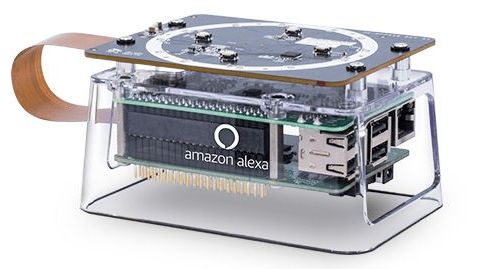By Gary Elinoff, contributing writer
By now, everybody knows about the Amazon Echo. The device connects via Wi-Fi to Alexa Voice Services (AVS), Amazon’s cloud-based personal assistant service. The user speaks to the Echo’s microphone, and with the help of Alexa, the command is interpreted. You may have asked for a song to be played on Echo’s speaker, to hear how your favorite sports team is doing, or perhaps even to control smart devices within your home, such as a garage door or a light switch.
Amazon has decided to invite other participants to join the AVS bandwagon, and part of Amazon’s motivation is, of course, profit. As described in an article in Forbes , “Through Alexa voice commands, users can access Amazon Prime services like music streaming or even shop on Amazon.” So, to make it easier for other manufacturers to create their own smart devices to exploit Alexa, Amazon is introducing two new development kits to make the task easier.

Amazon Alexa. Image source: Amazon.
Alexa mobile accessory kit
As described by Amazon, this kit is geared to OEMs designing audio-capable devices such as smart watches and other wearable devices destined to be Alexa-capable. Alexa integration is not simple, but this kit makes it unnecessary for OEMs to reinvent all of the hardware and software needed to perfect the connection. Through the use of this kit, OEM development teams no longer need to perform the bulk of the coding for their Alexa integration, according to Amazon .
When the wearable discerns a command, it will communicate via Bluetooth to a mobile device such as a smartphone, where it will encounter the Amazon Alexa App, which itself is the link to AVS. Amazon describes this as accessing “Alexa by pairing via Bluetooth to the Amazon Alexa App.” This frees the connected device from the requirements to communicate directly to AVS via the cloud, which would require far more power consumption than Bluetooth communication and also allows the device to retain its small form factor.
Alexa premium far-field development kit
Like the Alexa mobile accessory kit, the far-field voice development kit makes it easier for OEMs to incorporate Alexa into their new devices. In this instance, the units are generally static, tabletop devices. They are themselves Wi-Fi-enabled and destined to communicate directly to AVS without going through an intermediary device.
Another difference is that this kit is especially designed to work in noisy environments, with music blaring, people talking, and the general pandemonium of family life. A single digital signal processor (DSP) chip contains much of the circuitry needed to process voice commands, greatly speeding up time-to-market for designers.
As described by Amazon , the dev kit has boards for devices destined to sit in the center of a room, and for those destined for placement next to a wall. The difference is that the former must take in and interpret sound coming from anywhere in a 360-degree circle, while the latter devices need only to scan a 180-degree vista, as the second half of the “circle” is cut off by the wall.
It can be expected that with this boost provided by Amazon, many OEMs will jump on the Alexa bandwagon, which may be a very effective way for Amazon to more effectively compete with Apple’s Siri and Google Assistant.
Advertisement
Learn more about Electronic Products Magazine





